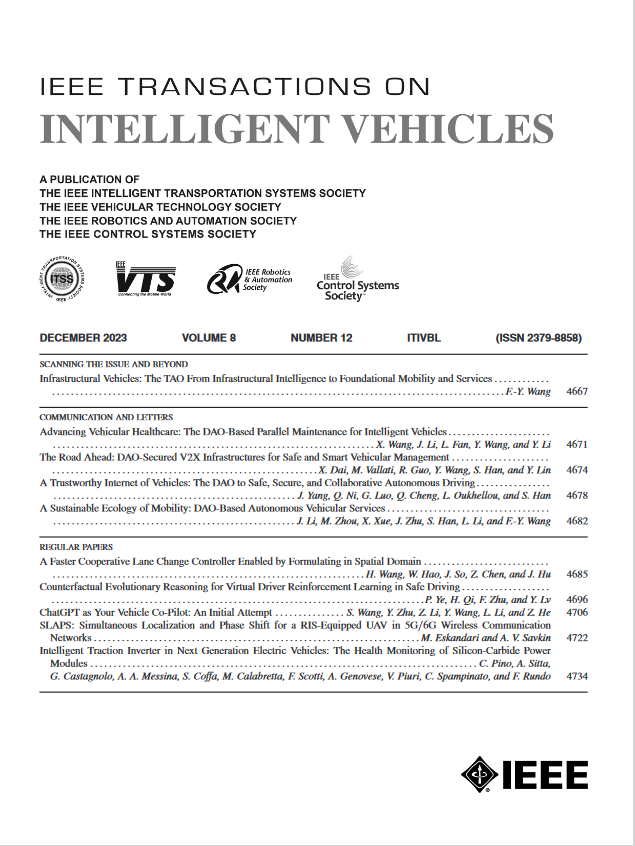A Cognitive-Based Trajectory Prediction Approach for Autonomous Driving
IF 14
1区 工程技术
Q1 COMPUTER SCIENCE, ARTIFICIAL INTELLIGENCE
引用次数: 0
Abstract
In autonomous vehicle (AV) technology, the ability to accurately predict the movements of surrounding vehicles is paramount for ensuring safety and operational efficiency. Incorporating human decision-making insights enables AVs to more effectively anticipate the potential actions of other vehicles, significantly improving prediction accuracy and responsiveness in dynamic environments. This paper introduces the Human-Like Trajectory Prediction (HLTP) model, which adopts a teacher-student knowledge distillation framework inspired by human cognitive processes. The HLTP model incorporates a sophisticated teacher-student knowledge distillation framework. The “teacher” model, equipped with an adaptive visual sector, mimics the visual processing of the human brain, particularly the functions of the occipital and temporal lobes. The “student” model focuses on real-time interaction and decision-making, drawing parallels to prefrontal and parietal cortex functions. This approach allows for dynamic adaptation to changing driving scenarios, capturing essential perceptual cues for accurate prediction. Evaluated using the Macao Connected and Autonomous Driving (MoCAD) dataset, along with the NGSIM and HighD benchmarks, HLTP demonstrates superior performance compared to existing models, particularly in challenging environments with incomplete data.基于认知的自动驾驶轨迹预测方法
在自动驾驶汽车(AV)技术中,准确预测周围车辆动向的能力对于确保安全和运营效率至关重要。将人类决策见解纳入其中,可使自动驾驶汽车更有效地预测其他车辆的潜在行动,从而显著提高动态环境中的预测准确性和响应速度。本文介绍了类人轨迹预测(HLTP)模型,该模型采用了师生知识提炼框架,其灵感来源于人类的认知过程。HLTP 模型包含一个复杂的师生知识提炼框架。教师 "模型配备自适应视觉扇区,模仿人脑的视觉处理过程,尤其是枕叶和颞叶的功能。学生 "模型侧重于实时互动和决策,与前额叶和顶叶皮层的功能相似。这种方法可以动态适应不断变化的驾驶场景,捕捉重要的感知线索,从而进行准确预测。通过使用澳门互联与自动驾驶(MoCAD)数据集以及 NGSIM 和 HighD 基准进行评估,HLTP 与现有模型相比表现出更优越的性能,尤其是在数据不完整的挑战性环境中。
本文章由计算机程序翻译,如有差异,请以英文原文为准。
求助全文
约1分钟内获得全文
求助全文
来源期刊

IEEE Transactions on Intelligent Vehicles
Mathematics-Control and Optimization
CiteScore
12.10
自引率
13.40%
发文量
177
期刊介绍:
The IEEE Transactions on Intelligent Vehicles (T-IV) is a premier platform for publishing peer-reviewed articles that present innovative research concepts, application results, significant theoretical findings, and application case studies in the field of intelligent vehicles. With a particular emphasis on automated vehicles within roadway environments, T-IV aims to raise awareness of pressing research and application challenges.
Our focus is on providing critical information to the intelligent vehicle community, serving as a dissemination vehicle for IEEE ITS Society members and others interested in learning about the state-of-the-art developments and progress in research and applications related to intelligent vehicles. Join us in advancing knowledge and innovation in this dynamic field.
 求助内容:
求助内容: 应助结果提醒方式:
应助结果提醒方式:


